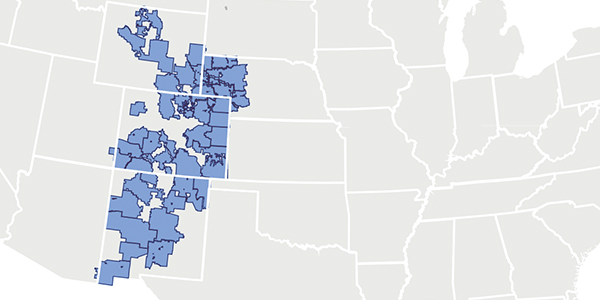Colorado cooperative Tri-State Generation and Transmission Association said Wednesday it will cut its rates by 8% by the end of 2023 and give members additional flexibility to provide their own power, addressing two of its members’ most frequent complaints.
CEO Duane Highley acknowledged during a press conference that members had asked for more leeway in self-supply options to increase their use of renewable energy, calling the actions a “green energy dividend.”
“It’s been lots of work, but the cooperatives have come together cooperatively to find ways to make this work for everyone,” Highley said, apparently unaware of his play on words. “We’ve all agreed this is a fair way to share costs.”
Highley was backed by two member representatives, Poudre Valley Rural Electric Association CEO Jeff Wadsworth and Southeast Colorado Power Association CEO Jack Johnston, and former Colorado Gov. Bill Ritter, director of the Center for the New Energy Economy.
Ritter lauded Tri-State for its Responsible Energy Plan, which the co-op unveiled in January with similar fanfare. The plan’s components include 50% renewable consumption by 2024, reduced emissions by closing coal plants in Colorado and New Mexico, and additional self-supply and local renewable energy flexibility for members. (See Tri-State to Retire 2 Coal Plants, Mine.)
“This was not an easy result to get to. None of this is easy,” Ritter said. “They’re living up to the commitments they made in the Responsible Energy Plan. We’re going to make a commitment to lower rates for the next few years. That is something I think we should all applaud.”
The announcement followed a meeting at which Tri-State’s Board of Directors approved the rate cut and the Contract Committee’s process to implement partial requirements contracts with its utility members.
“You typically don’t hear about electric utilities lowering rates, so we’re grateful to Tri State and board for this big lift,” Wadsworth said.
Beginning with an “open season” nominating period in early 2021, utility members can transition to the new contracts by expressing their interest in shares of the 300-MW of system-wide self-supply capacity allocation. The open season capacity accounts for 10% of Tri-State’s system peak demand.
Members can self-supply up to 50% of their load requirements, subject to availability in the open season. This expands on the current 5% self-supply provision and a new community solar provision.
The 5% cap has frustrated Tri-State’s 42 utility members, some of whom are involved in regulatory litigation to leave the co-op. (See Tri-State, Delta Officially Part Ways.)
Tri-State has recently added three non-utility members, making it FERC-jurisdictional. The commission in March found Tri-State to be under its jurisdiction, a ruling it affirmed in August. (See FERC Affirms its Jurisdiction over Tri-State G&T.)
FERC Rejects Interconnection, GIA Procedures
As the press conference proceeded online, FERC issued an order rejecting Tri-State’s proposed Tariff revisions modifying its generator interconnection procedures and generator interconnection agreements (GIAs) without prejudice to a submitted revised proposal (ER20-2593).
Tri-State said it intends to refile a revised proposal.
FERC in March accepted Tri-State’s Tariff revisions establishing the jurisdictional rates and terms and conditions for transmission service over its Western Interconnection facilities, but set the matter for hearing and settlement judge procedures to determine their justness and reasonableness. (See “Ruling Permits Tri-State to Become FERC Jurisdictional,” SPP FERC Briefs: Week of March 16, 2020.)
Tri-State proposed to reform its interconnection queue by transitioning from the pro forma sequential first-come, first-served study approach to a first-ready, first-served cluster study. The cooperative said the change was consistent with or superior to its pro forma large and small generator interconnection procedures (LGIP/SGIP) and the large and small GIAs.
The revisions would have established an informational interconnection study process — to assist customers make business decisions about their generation facilities before entering the queue — and a definitive interconnection study process. Tri-State said interconnection customers must demonstrate site control and meet increasingly stringent readiness milestones as they advance through the interconnection phases.
FERC found that Tri-State did not demonstrate several revisions to be consistent with or superior to the pro forma LGIP: 1) its proposal to allocate network upgrade costs based on a distribution factor analysis; 2) the requirement for interconnection customers to select energy or network resource interconnection service (ERIS/NRIS) before beginning one of the study process’ phases; and 3) the requirement for interconnection customers entering a transitional process to demonstrate readiness within 10 days of the revised LGIP’s effective date.





